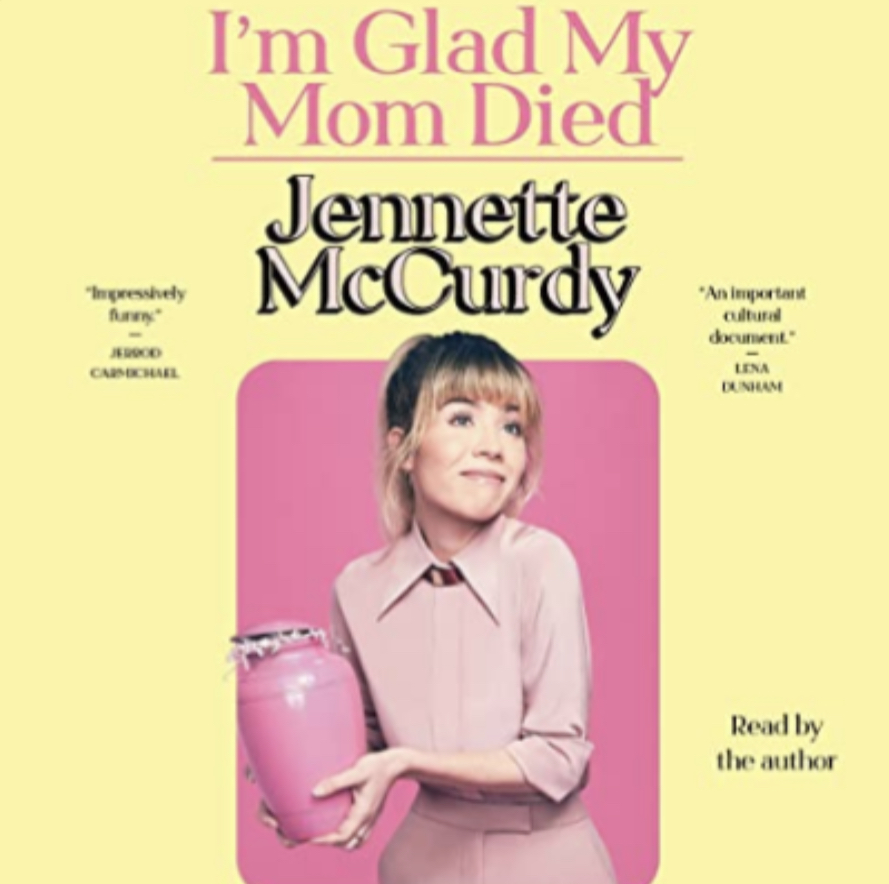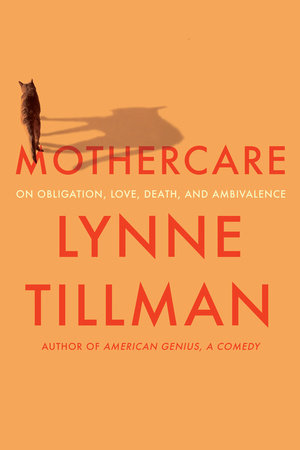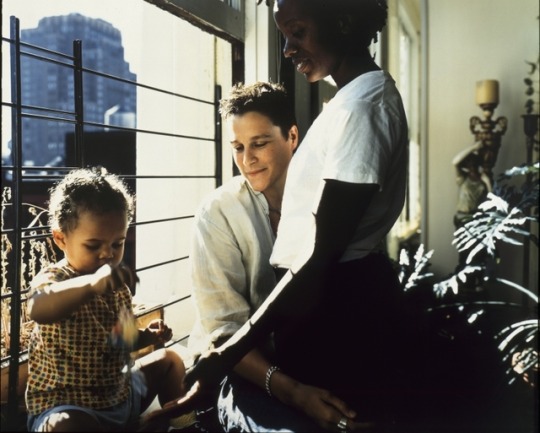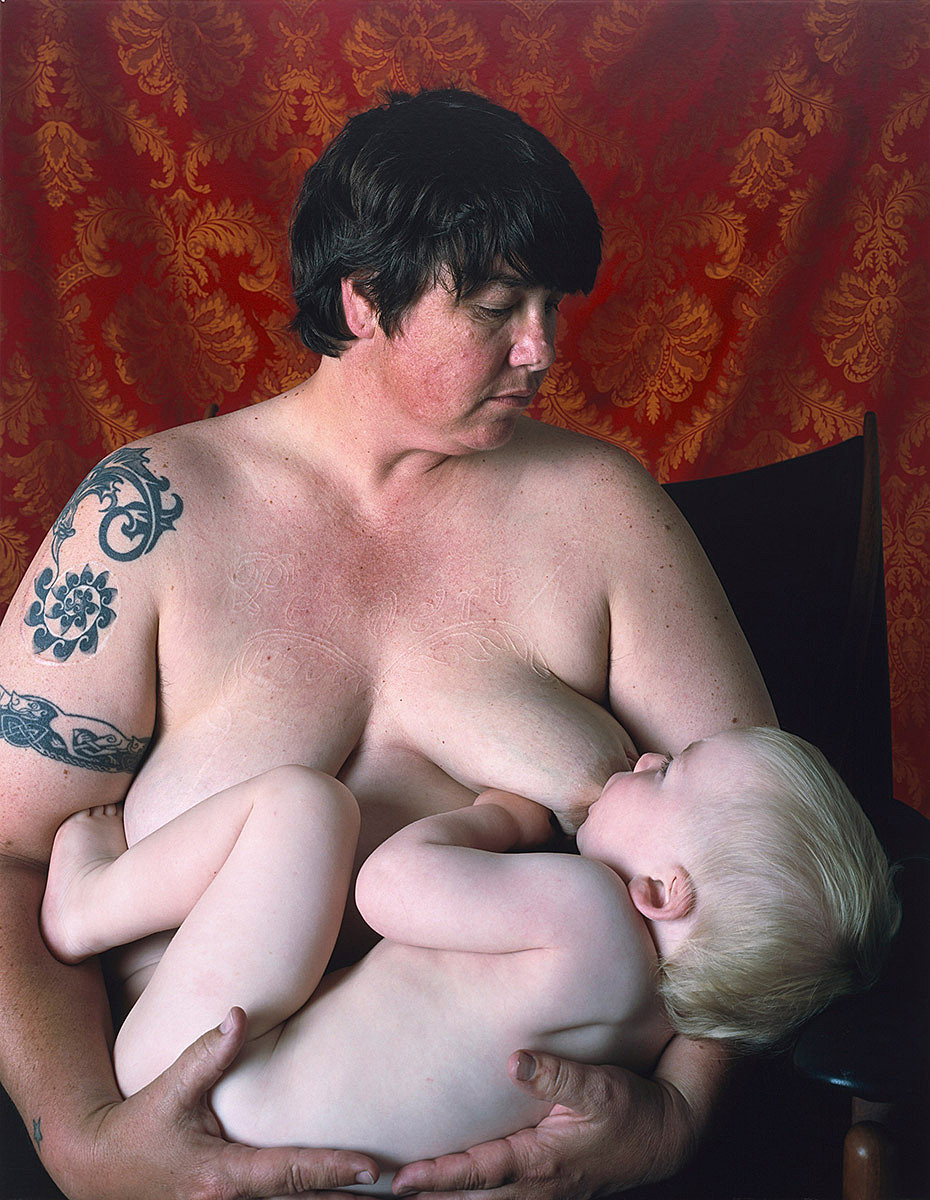Birthing, caring, criticizing, arguing, loving. Whether present or absent, mothers connect us all. Currently, they are frequently being described in literature and also thoroughly criticized in books such as “I’m Glad My Mom Died” by Jennette McCurdy and “Mothercare” by Lynne Tillman, although, according to Sarah Speck, most motherhoods and maternalities are still based on a heteronormative and patriarchal understanding. So what does lesbian motherhood mean and how is it represented by queer artists such as Catherine Opie, Cathy Cade, or A.L. Steiner?
Queer motherhood poses particular hurdles
To answer this question, it is essential to look at politics. If we turn our gaze to the USA, where the artists mentioned here grew up and live, we find “traditional marriage” is firmly anchored in politics. For example, the 1970s saw the first court rulings on couples demanding official recognition of their marriages, including both gay and lesbian couples. These were widely rejected, and marriage was defined as a union between a man and a woman. In 1996, Bill Clinton signed the Defense of Marriage Act, but this was not enough to “protect traditional marriage” for many conservative politicians. Subsequently, George W. Bush argued as late as 2004 that same-sex marriages would undermine “the welfare of children and the stability of society.” Only since 2015 have same-sex marriages in the U.S. been largely state-dependent and possible after hearings.

Jenette McCurdy, I’m Glad My Mom Died, Image via mavnewspaper.com

Lynne Tillman: Mothercare, Image via penguinrandomhouse.com
Unsurprisingly, queer motherhood is an individual experience that is fraught with particular hurdles, traumas, and emotions due to our heteronormative and binary social and political structures. Margaret F. Gibson argues that political disinterest or rejection, and lack of education related to queer family formation, result in experiences for queer parents that cannot be compared to heteronormative family structures. Starting with the desire to have a child, which can fail due to a lack of financial means, lack of education, or for biological reasons and can lead to traumatic experiences, through to fears regarding possible discrimination against the parents or the child.
Trauma, pain, and hope
The pain of such an experience is visualized by Catherine Opie in her self-portraits as well as in a series of photographs showing lesbian households in the 1990s. In her series entitled “Domestic”, she offers intimate glimpses into her community in their own homes or apartments. Almost every ethnicity, gender identity, sexuality, and family structure is shown. With children or without, Opie repeatedly emphasizes that these are all full families and now makes them visible. As a result, major museums such as the Guggenheim (New York) and the Tate (London) have purchased individual works from the “Domestic” series. Yet the physical and psychological pain of forming a family as a queer person is most visible in Opie’s portraits. Stylistically modeled on traditional portraiture by Hans Holbein, Opie herself, as well as other models, have their backs turned to the camera. The portraits tell a story: In “Self-Portrait/Cutting” she shows her back as a canvas on which an image of a house and two stick figures have been carved. Blood still drips from the wounds, and the cuts are fresh. The figures wear skirts, they smile, and are surrounded by clouds, a large sun, and birds. The image is reminiscent of an idyllic children’s drawing, but the brutal means that have obviously been used here convey pain and discomfort in figurative form.

Catherine Opie, Domestic series (1995-98), Image via tumblr.com

One year later Opie went a few steps further with “Self Portrait/Pervert”. Now she shows herself topless from the front. Her face is hidden under a leather fetish mask, she wears a nipple piercing in her right nipple, and a row of needles have been inserted symmetrically and at regular intervals into her arms. On her sternum she has carved the word “Pervert” and added ornamentation reminiscent of generic tattoos from the 1990s. All the wounds are carefully considered and systematic; the process behind them is a deliberate act that triggers pain. The word “pervert” here refers to a rich history of discrimination against queer people.
Ten years later, Opie shows herself topless again in “Self Portrait/Nursing”. Her face is now also free, while the scars of the “Pervert” inscription are still visible, but healed. She holds her naked son in an almost iconographic pose and lets him suckle on her breast. She is a mother now. Or was she already when the first portrait was taken? Opie’s portraits range from the desire for a family, to discrimination, to motherhood and thus tell the painful individual story of a queer woman.

Catherine Opie: Self-Portrait/Nursing, 2004 © Catherine Opie, Image via guggenheim.org
No room for traditional stereotypes
Cathy Cade, another US lesbian photographer, also examines her lesbian community in private moments. In doing so, however, she does not create staged moments with arranged backgrounds and poses, but rather snapshots in black and white. In “Laurie Hauer and Gusse II” (1989), she shows two women sitting in front of a bed. One woman laughs as she plays with her son on her lap. The other is looking at the boy, while on her lap lies an infant in diapers. At his navel you can see the remains of an umbilical cord. It is a carefree scene of a family through whose ethnicities lesbian motherhood becomes visible. A black woman with a black son and a white woman with a white infant. With the knowledge that this is a lesbian couple, the processes of this family formation can be surmised: Both women could each have been pregnant and given birth at one time, they could have adopted the children, or they could have relied on a surrogate mother. Yet however one wants to analyze the depicted family structure, it goes against the heteronormative concept of family and questions existing structures. At the same time, images like this that are published and/or exhibited are expressions of solidarity for other queer people. They convey that forming a family is not impossible and perhaps even confirm such people’s decision to start a family themselves.

A space of solidarity
This communal sharing of experience, which in Cade’s work can be understood as an expression of solidarity, is also at the center of A.L. Steiner’s “Puppies & Babies” (2012), for which the artist transformed photographic snapshots of queer women into an installation. Here, Steiner papered the walls with intimate images, some snapshots, some posed shots, in which feminine-presenting women are shown pregnant, breastfeeding, or naked in bed with their dogs and children. “Puppies” here can also refer to breasts, of course, and with this play on words Steiner lends a certain lightness to the provocative installation.
What the works by queer artists on motherhood thus make clear is that they are to be understood above all as an act of protest against the political and social restrictions and reservations placed on same-sex parenthood. At the same time, they function as an expression of solidarity with all those who have been shaped by similar experiences – be it the same often unfulfilled desire to form a family and the obstacles that come with it, the residual trauma, or even feelings of gratitude towards their own community. They thus unite to form a crucial message: With or without a child, regardless of family constellation, gender and identity, wishes and hopes, every family is a full family.

A.L. Steiner: Puppies & Babies, 2012, Image via hellomynameissteiner.com